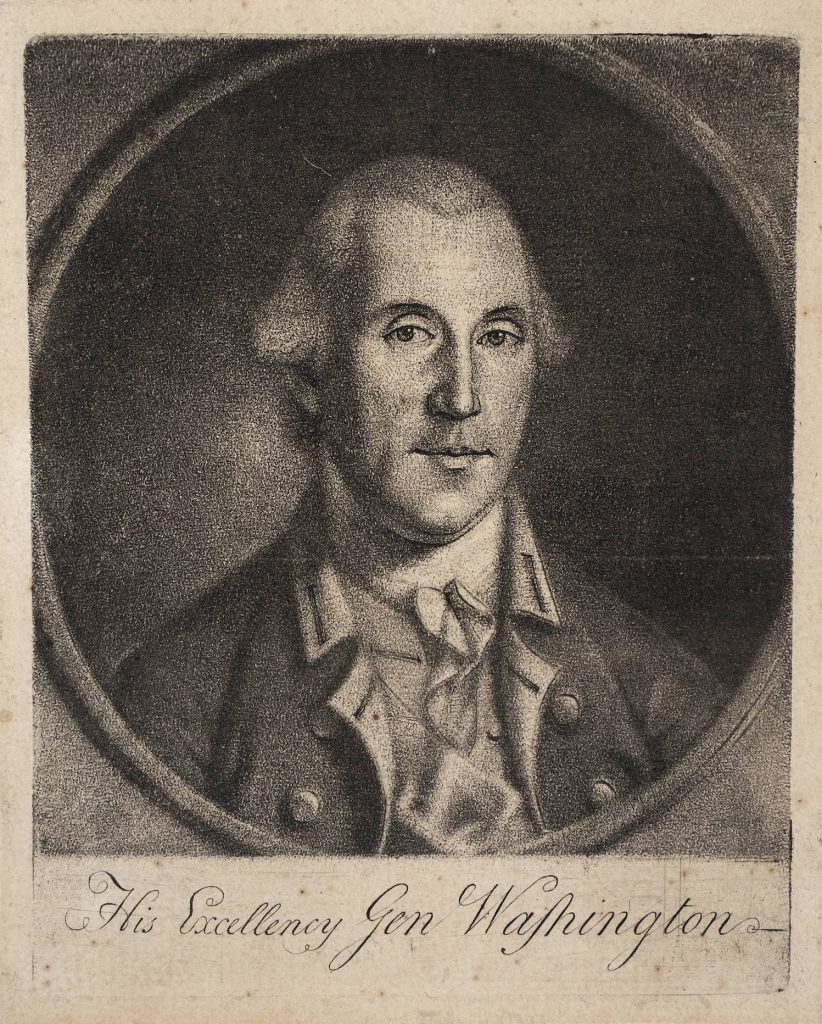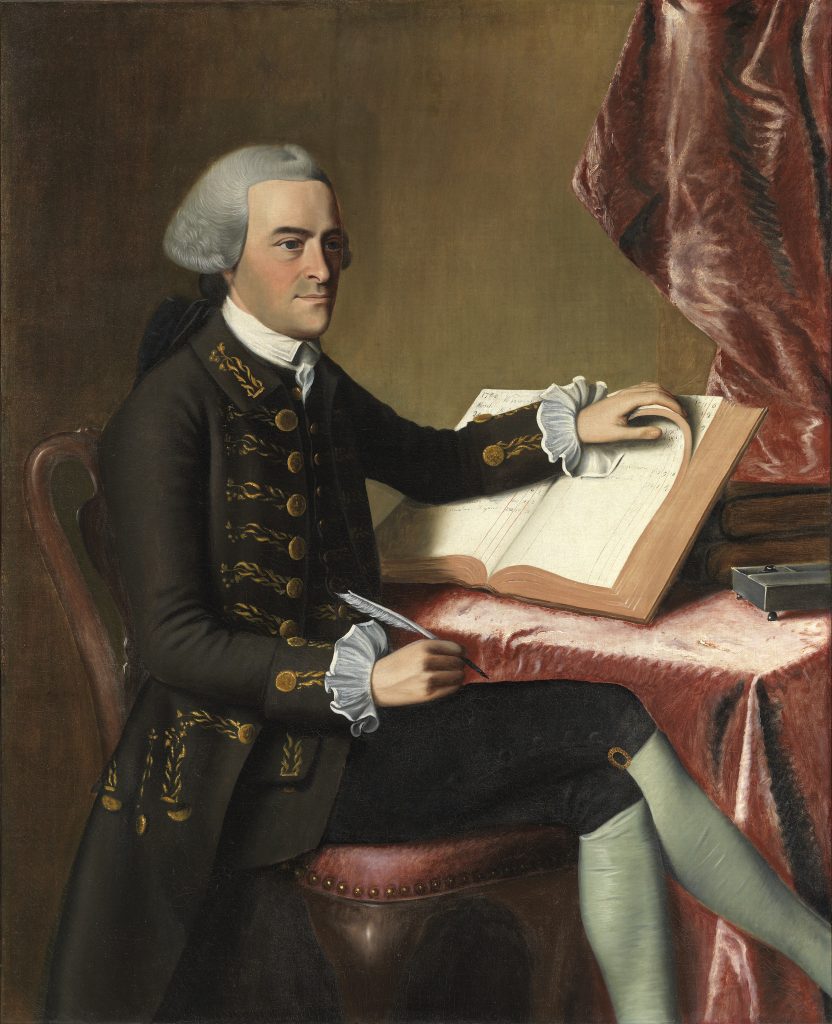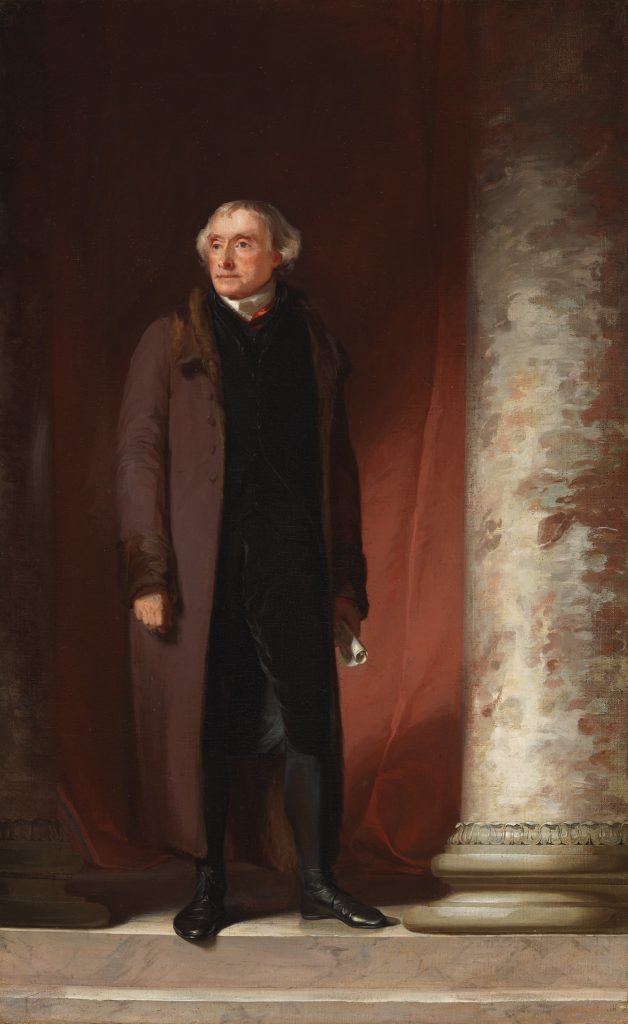Laura James, Bridgewater-Raritan Regional High School, Bridgewater, New Jersey
DESIGN LEVEL: High School
Overview
What did being an American mean following the Revolution—politically, socially, culturally and economically? Who were America’s heroes and what where their core values? In this lesson, students will analyze the evolution of what it meant to be an American during the early republic.
Objectives
Students will . . .
- Investigate primary source document sets and use their analysis of those documents to create an “I Am” poem reflecting various aspects of American beliefs and culture in the early republic. In particular, students will study resources from the following categories: 1) Admired and Valued Ideals and Personal Character Traits; 2) Critical Contemporary Events; 3) Admired Individuals and Heroes; 4) Skills/Industries/Designs Unique to Eighteenth Century American Craftsmen, Artists and Artisans; 5) Participation in Government and Civic Society; 6) Unresolved Issues.
- Activate prior knowledge about the causes of the Revolution, the Revolutionary War and the Constitutional Convention.
Materials
- You: Present Day activity by Ms. James
- “I Am” Poem Template by Ms. James
- Writing an “I Am” Poem
- Source Analysis Notes Sheets by Ms. James
DOCUMENT AND OBJECT SETS REFLECTING SIX CATEGORIES OF STUDY:
Admired and Valued Ideals and Personal Character Traits
- Powder horn owned by David Allen, ca. 1776, The Society of the Cincinnati. [also see gallery below]
- General Lafayette at the Anniversary of the Battle of York Town, Oct. 19, 1824, ca. 1824-1834, The Society of the Cincinnati.
- Original Institution of the Society of the Cincinnati, 1783. [also see gallery below]
- John Quincy Adams’ Declaration of Independence Engraved in Copperplate, 1823, U.S. Department of State, Diplomatic Reception Rooms: John Quincy Adams Drawing Room
- Badge of Military Merit, ca. 1782-1783, Collection of the American Independence Museum, Exeter, NH and the Society of the Cincinnati in the State of New Hampshire. [see gallery below]
- Discharge of Private John Hall, 1783, The Society of the Cincinnati. [see gallery below]
- “The Liberty Song,” 1768, Dickinson Archives and Special Collections.
- John Dickinson’s Hit Single: Liberty Song
- George Washington to the Delegates of the State Societies of the Cincinnati, May 1790. [also see gallery below]
- George Washington, Newburgh Address, March 15, 1783.
- Newburgh Address Article, Mary Stockwell, The Fred W. Smith National Library for the Study of George Washington at Mount Vernon, Digital Encyclopedia.
- George Washington and the Newburgh Conspiracy, 1783, Gilder-Lehrman History Resources.
- From George Washington to United States Congress, December 23, 1783.
- General George Washington Resigning His Commission to Congress As Commander in Chief of the Army at Annapolis, Maryland, December 23d, 1783, John Trumbull, oil on canvas, Commissioned 1817, purchased 1824, Image courtesy of Architect of the Capitol.
Critical Contemporary Events
- 13 A.LL.S by Lieutenant William Barton : from Jermintown (i.e. Germantown), Whitemarsh, Valley Forge, Elizabethtown, Tioga, and elsewhere] July 1777 – 3 Oct. 1779, The Society of the Cincinnati. [see gallery below]
- Plan of the Investment of York and Gloucester, Sebastian Bauman Map, 1782, The Society of the Cincinnati. [see gallery below]
- Four Revolutionary War Scenes: Battle of Bunker Hill, Death of General Wolfe, Camp at Valley Forge, and Surrender of Cornwallis (engravings from an unknown book), The Society of the Cincinnati.
- Washington at Princeton, Charles Willson Peale, 1779.
- “He Comes, The Hero Comes!” Recording by David and Ginger Hildebrand, George Washington: Music for the First President, 1999. [see gallery below]
- “The President’s March” Audio recording by David and Ginger Hildebrand, George Washington: Music for the First President, 1999. [see gallery below]
Admired Individuals and Heroes
- His Excellency Gen. Washington, Charles Willson Peale, 1778, The Society of the Cincinnati. [see gallery below]
- “General Washington” Audio recording by David and Ginger Hildebrand, George Washington: Music for the First President, 1999. [see gallery below]
- “A Toast” Audio recording by David and Ginger Hildebrand, George Washington: Music for the First President, 1999. [see gallery below]
- Enclosure: Poem by Phillis Wheatley, 26 October 1775.
- George Washington to Phillis Wheatley, 28 February 1776.
- Portrait: Henry Knox (1750-1806) Painted by Peter Roos (1850-1910), after Gilbert Stuart (1755-1828) (late 19th, early 20th century), The Society of the Cincinnati. [see gallery below]
- Abigail Adams to John Adams, 16 July 1775 (descriptions of Washington and Lee).
- Alexander Hamilton, Major General of the armies of the United States of America, Secretary of the Treasury, &c. &c. (engraving) William Rollinson, 1804, The Society of the Cincinnati.
- Portrait of John Hancock, copy of John Singleton Copley 1765 by Edward Savage 1785, U.S. Department of State Diplomatic Reception Rooms: Gallery. [see gallery below]
Skills/Industries/Designs Unique to Eighteenth Century Craftsmen Artists and Artisans
- Lighthouse Clock, Simon Willard 1822-1830, U.S. Department of State Diplomatic Reception Rooms: Jefferson Reception Room.
- Tall Case Clock, William Clagget, U.S. Department of State Diplomatic Reception Rooms: Jefferson Reception Room.
- Tankard, Myer Myers 1785, U.S. Department of State Diplomatic Reception Rooms: John Quincy Adams Drawing Room.
- Teapot, Philip Syng, Jr. 1755, U.S. Department of State Diplomatic Reception Rooms: John Quincy Adams Drawing Room.
- Linen Press, Michael Allison 1800-1810, U.S. Department of State Diplomatic Reception Rooms: James Monroe Reception Room.
- Chest of Drawers, Thomas Sherburne 1770-1785, U.S. Department of State Diplomatic Reception Rooms: Gallery.
- Slant Front Desk, John Townsend 1765, U.S. Department of State Diplomatic Reception Rooms: Gallery.
Participation in Government and Civic Society
- Collection of 14 letters & documents relating to William Russell’s experiences as a prisoner-of-war during the Revolutionary War, 1778-1783, Society of the Cincinnati. [see gallery below]
- Jonathan Birge to Priscilla Birge, 20 October 1776, Society of the Cincinnati. [see gallery below]
- Desk & Bookcase, Benjamin Frothingham 1753, U.S. Department of State Diplomatic Reception Rooms: Entrance Hall.
- Portrait of Thomas Jefferson, Thomas Sully, 1821, U.S. Department of State Diplomatic Reception Rooms: John Quincy Adams Drawing Room.
- An Authentic Narrative of the Life of Joshua Slocum, 1844, The Society of the Cincinnati. [see gallery below]
- Additional suggested documents: selections from The Federalist Papers, pre-Revolution resolutions from colonial assemblies and legislatures that discuss the right to participate in government or the denial of participation in government.
Unresolved Issues
- A Pensioner of the Revolution, John Neagle, 1830, The Society of the Cincinnati. [see gallery below]
- A plea for the poor soldiers, or An essay, to demonstrate that the soldiers and other public creditors: who really and actually supported the burden of the late war, have not been paid! Ought to be paid! Can be paid! And must be paid!, Pelatiah Webster, 1790, The Society of the Cincinnati. [also see gallery below]
- Abigail Adams to John Adams, 31 March 1776.
- Henry Knox to John Hancock, 20 October 1782, The Society of the Cincinnati.
- Moll Pitcher at the Battle of Monmouth, Painted by D.M. Carter, engraved by John Rogers, 1856, The Society of the Cincinnati. [see gallery below]
- Anti-Slavery Medallion, Am I Not A Man and A Brother, Henry Webber, artist, struck in Great Britain, 1787, U.S. Department of State Diplomatic Reception Rooms.
- Lafayette’s Testimonial to James Armistead Lafayette, 21 November 1784.
- Receipt of Pay-Table Committee, Hartford, 7 June 1782 (signed for Dick Freedom by Cuff Liberty), The Society of the Cincinnati. [see gallery below]
Recommended Time
Two 40-minute class periods for document and object analysis, with the “I Am” poem assigned as the assessment for homework.
Activity
After receiving an introduction of the lesson, students will complete the You: Present Day bell ringer activity, then share their answers in a small group.
Introduce the “I Am” poem assignment by sharing Ms. James’ template and online example at Writing an “I Am” Poem.
Students will investigate three objects or documents from each of the six categories and record their thoughts on the source analysis notes sheets.
As a class, students will discuss the objects and documents and identify common themes and ideas.
As homework, students will create an “I Am” poem, with each line comprised of two or three sentences, that will include historic information based on the documents and objects analyzed in class.
Suggested Modifications
- Vocabulary lists focused on words that have different definitions in the time period being studied, or phrases that are no longer used that are important to understanding the document.
- Transcriptions of documents and songs.
- Transcriptions of video clips if closed captioning is not available.
- The addition of prompt questions to the source analysis note sheets to guide student note taking for each of the six categories.
- Descriptions relating to the symbolism and significance of each document and object to aid in interpretation for students who struggle with abstract concepts. By looking at the description of the object or document first, they will be able to locate the symbols and key ideas in the document or object.
- An index of notes or screencasts from previous lessons to reference prior knowledge.
Distance Learning Modifications
- Use Jamboard or Google Classroom technology to facilitate small group discussions and analysis of documents and objects.
- Post document/object groups to Google Classroom for students to investigate online (either remotely or while social distancing in the classroom).
- Post a screencast example of the analysis of each type of document or object to model activity.
- In a “no contact” classroom, the activity could be set up as a gallery walk with three document/object groups each class period (one document/object per group at a time to socially distance students throughout the classroom).
Optional Extensions
- Students could role play/act out their answers to the categories of the “I AM” poem rather than writing the poem, or perform a dramatic reading of their poem role playing the character they created. Videos of this could be uploaded to share for distance learning.
- Teachers could continue to explore the theme of what defined Americans for successive time periods in American history.
- Higher level students could create two or more poems using different perspectives from each time period studied.
Standards Addressed
2020 NEW JERSEY STUDENT LEARNING STANDARDS
6.1.12.HistoryUP.2.a: Using primary sources, describe the perspectives of African Americans, Native Americans, and women during the American Revolution and assess the contributions of each group on the outcome of the war.
6.1.12.HistorySE.2.a: Construct responses to arguments in support of new rights and roles for women and for arguments explaining the reasons against them.
6.1.12.HistoryCA.2.a: Research multiple perspectives to explain the struggle to create an American identity.
6.1.12.CivicsPI.3.a: Analyze primary and secondary sources to determine the extent to which local and state issues, publications, and the rise of interest group and party politics impacted the development of democratic institutions and practices
6.1.12.HistoryCC.3.a: Evaluate the role of religion, music, literature, and media in shaping contemporary American culture over different time periods.
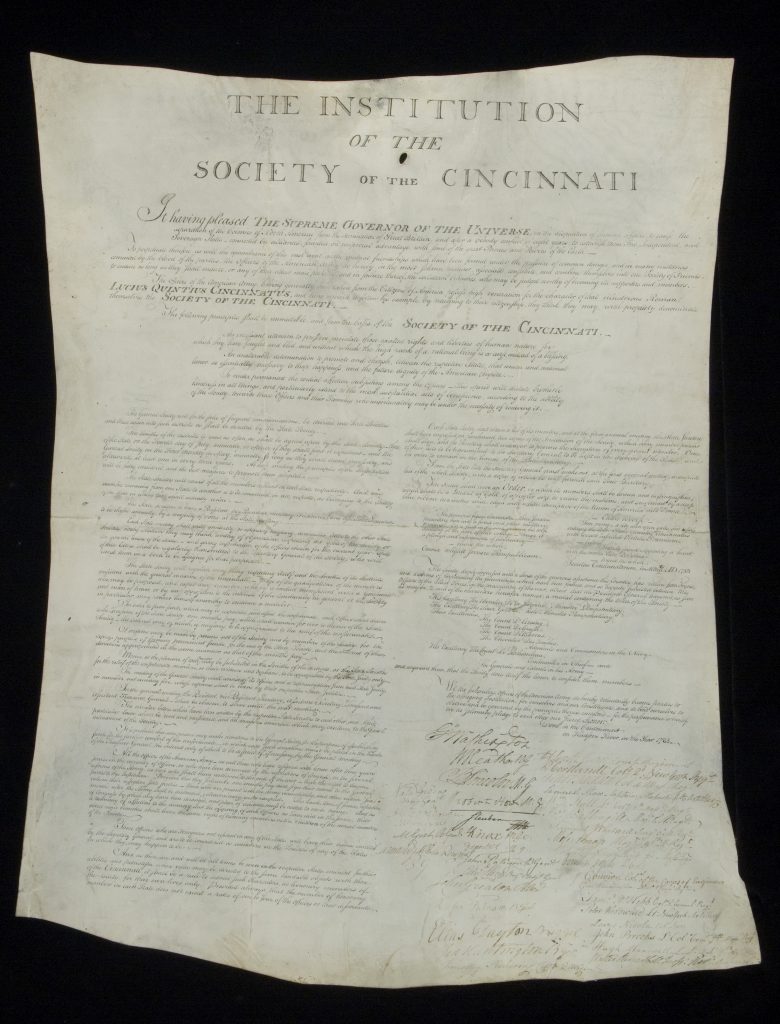
The Institution of the Society of the Cincinnati
May 1783The Society of the Cincinnati Archives
Adopted at the founding meeting on May 13, 1783, the Institution remains the principle guiding document of the organization to the present day. The first official copy was inscribed on a large, irregularly shaped sheet of parchment and signed by George Washington and thirty-five other officers. The Institution lays out the tenets and organizational structure of the Society, the rules of eligibility to membership, the establishment of constituent branches and details of the Society’s insignia. To join the Society, the original members were required to sign their names to the Institution, thus pledging their allegiance to the immutable principles upon which the Society was founded.
Badge of Military Merit
ca. 1782-1783Collection of the American Independence Museum, Exeter, NH and the Society of the Cincinnati in the State of New Hampshire. Gift of William L. Willey.
George Washington created the Badge of Military Merit—the first military decoration for enlisted men—on August 7, 1782. The award recognized distinguished conduct and was intended to encourage “virtuous ambition” and “every species of Military merit.” Soldiers honored with the award “shall be permitted to wear on his facings over the left breast, the figure of a heart in purple cloth, or silk, edged with narrow lace or binding.” Only two reputed examples are known, of which this is one. The decoration fell out of use after the Revolutionary War but was revived in 1932 as the modern Purple Heart.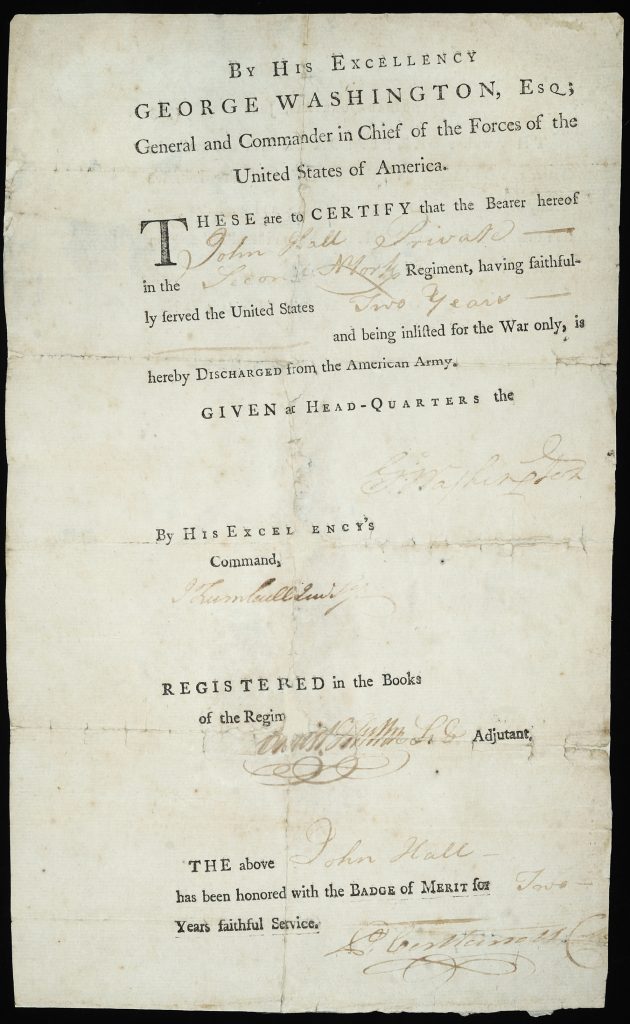
Discharge of Private John Hall
[1783]The Society of the Cincinnati, Gift of Robert L. Buell, 1966
In accordance with instructions from Congress, the soldiers of the Continental Army who had enlisted for the duration were furloughed in June 1783—and were sent home with no more than one month’s pay in cash and promissory notes for a few months additional pay. John Hall, a private in the Second New York Regiment, received this discharge, noting he “has been honored with the Badge of Merit for two years faithful service.”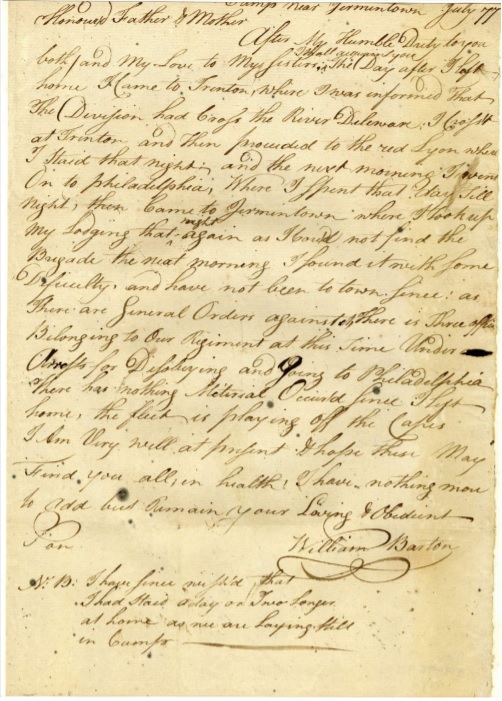
William Barton to Father and Mother
July 1777The Robert Charles Lawrence Fergusson Collection
These letters are addressed to Barton's father, Gilbert Barton, and other family members at Allentown, N.J. Letters are contained in a blue and buff leather clamshell case custom made by Handbridge Bindery. Several mention military events relating to Germantown, Valley Forge, the French fleet, prisoner exchanges, and Sullivan's campaign against the Iroquois, including the death of Capt. Davis; others describe camp life which "does not very well agree with me", homesickness, clothing and other supply needs Also included is a letter from Barton's friend Jno. Blair to Gilbert Barton, 24 Feb. 1778, [#5] advising that his son is unwell and "beggs that you would speak to Colo. Brearely [David Brearley] to write to Major [John] Conway to give him leave to go home." Barton, Blair, and Brearley were original members of the Society of the Cincinnati.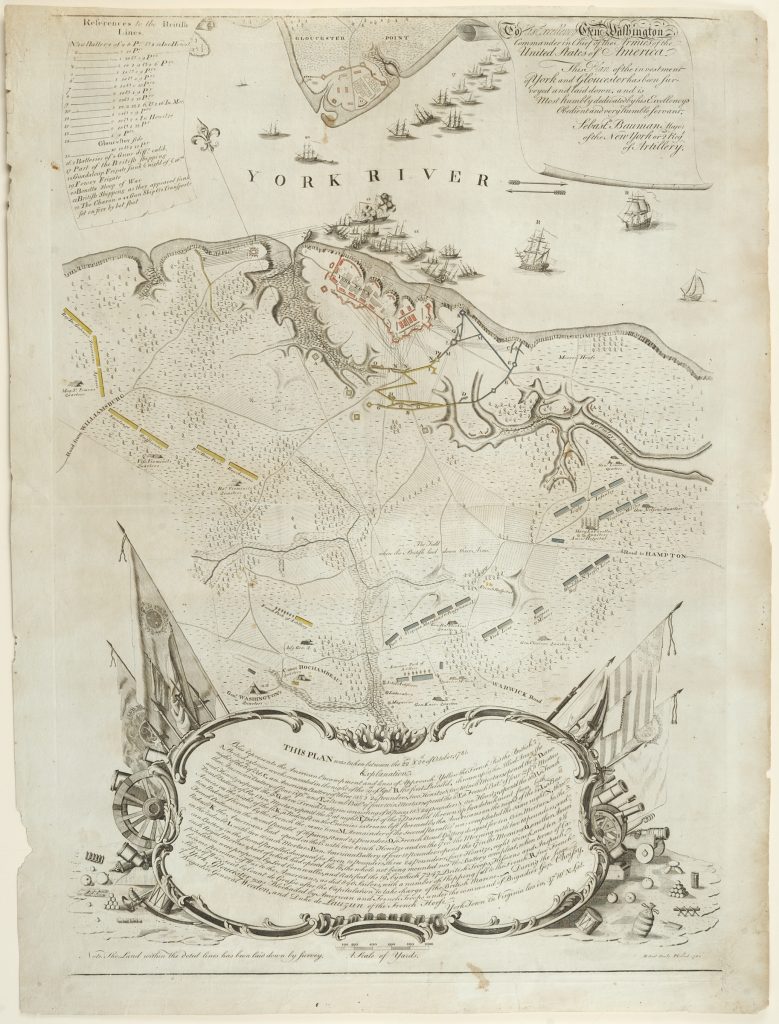
Plan of the Investment of York and Gloucester
Sebastian Bauman
Philadelphia, 1782The Robert Charles Lawrence Fergusson Collection
Within days of the British surrender at Yorktown, General George Washington directed Major Sebastian Bauman of the Second Regiment Continental Artillery to survey the battlefield and encampments. The following year Bauman collaborated with a Philadelphia engraver, Robert Scot, to publish this elegant large-scale map “in order that the public may form an idea of that memorable siege.” Dedicated to General Washington, Bauman’s plan provides remarkable detail of the topography, fortifications, siege works, positions of the American and British lines, headquarters of the commanding officers and “The Field where the British laid down their Arms.”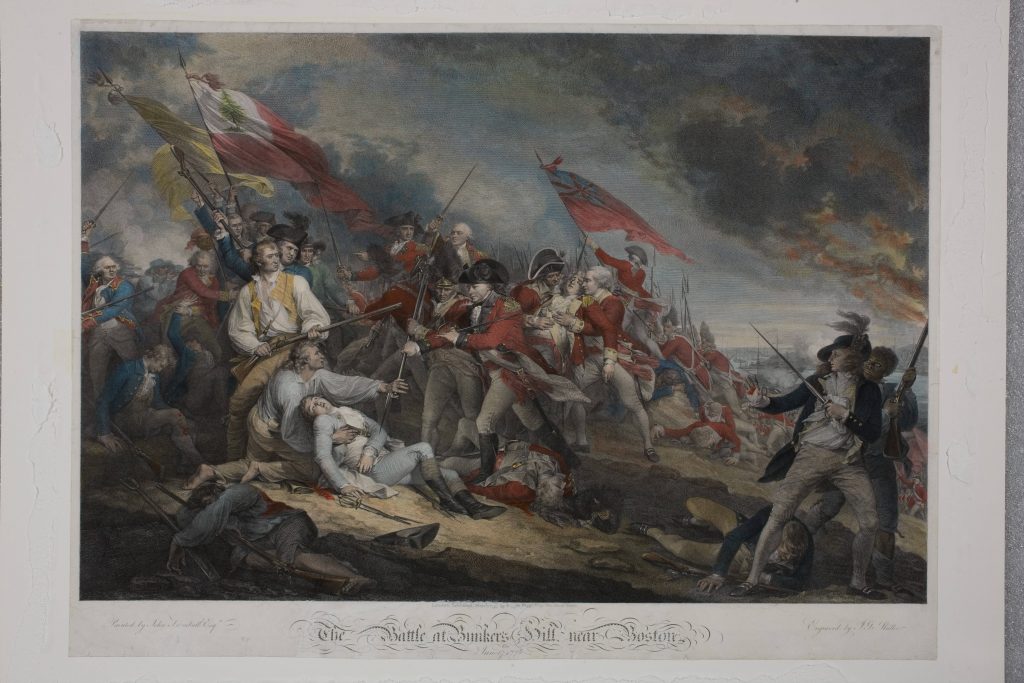
The Battle at Bunkers Hill near Boston the June 17th 1775
Johann Gotthard von Mueller, engraver, after John Trumbull
London: Antonio C. de Poggi, No. 91 New Bond Street, 1798The Robert Charles Lawrence Fergusson Collection
The scene of the battle with General Joseph Warren lying dead in the center surrounded by anxious officers with the battle raging in the background. This is a copy of the first engraving arranged by Trumbull after he completed his painting, titled, The death of General Warren at the Battle of Bunker's Hill, 17 June 1775, in Benjamin West's studio in London in 1786. Because no English engravers would produce a work celebrating the victory of the Americans during the Revolution, Trumbull had it engraved by Muller in Stuttgart and later it was published by A. C.de Poggi in London in 1798.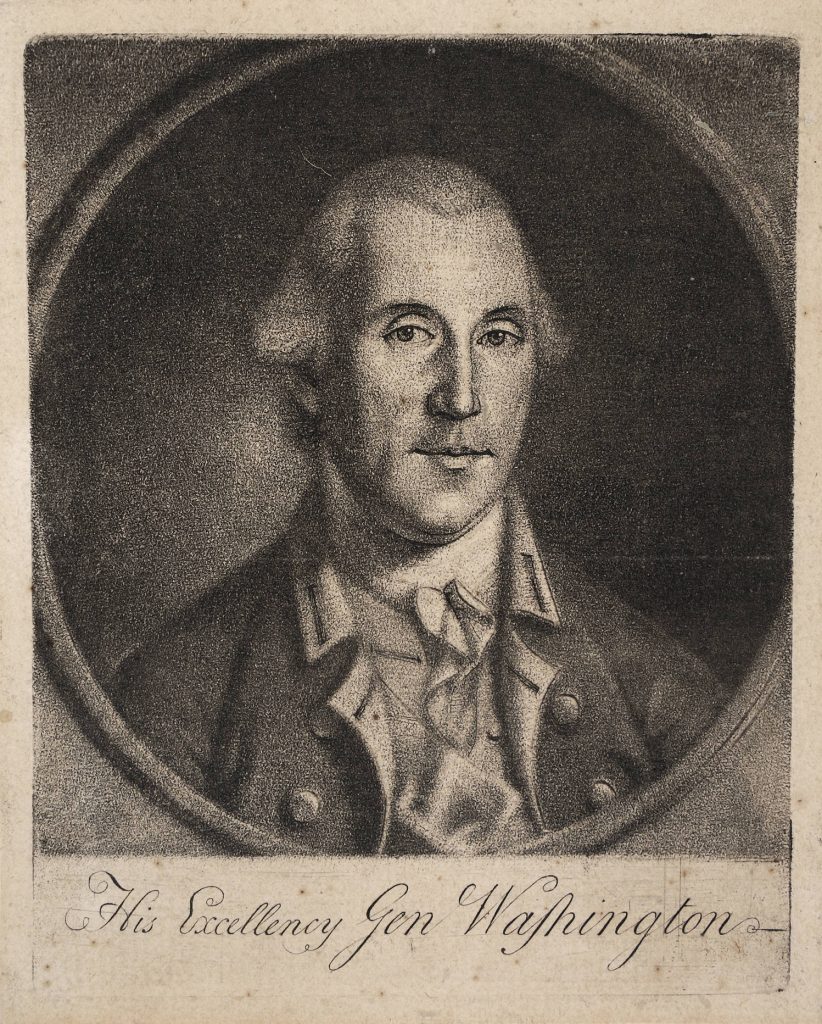
"His Excellency Gen Washington"
Charles Willson Peale
Philadelphia, 1778The Society of the Cincinnati, The Robert Charles Lawrence Fergusson Collection
Peale's mezzotint is based on his own painting of Washington from life, the first authentic likeness of Washington to appear in print. One of only three examples of the mezzotint known (the other examples are in the collection of the National Portrait Gallery, Washington, DC; and in the Archivo General de Indias, Seville, Spain).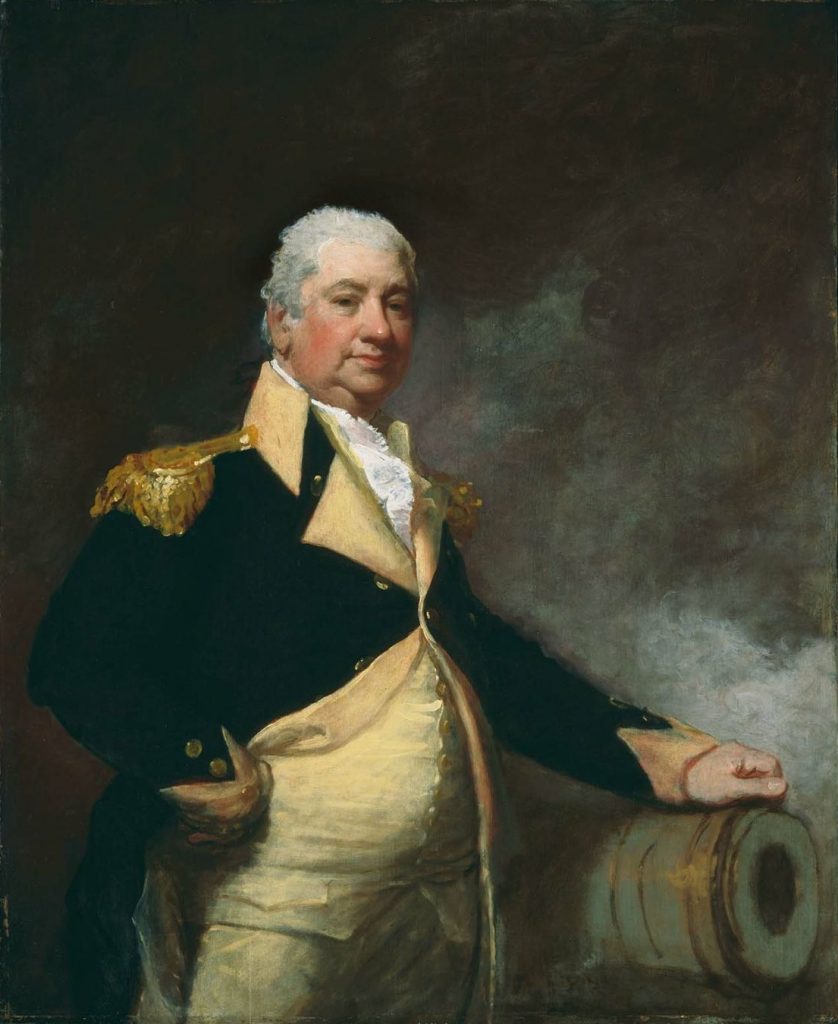
Peter Roos (1850-1910) after Gilbert Stuart (1755-1828)
Late 19th–Early 20th century
The Society of the Cincinnati, The Robert Charles Lawrence Fergusson Collection
Henry Knox, who served as chief of artillery in George Washington’s army, first described an organization of veteran officers in 1775. As the Revolutionary War drew to a close in 1783, Knox proposed the creation of the Society of the Cincinnati and drafted the original Institution. He served as the first secretary general of the Society and later as vice president general. This copy of Gilbert Stuart’s 1806 portrait of Henry Knox depicts the general in a post-Revolutionary War uniform standing next to a cannon—a reference to Knox’s role in the Continental Army. Knox was a twenty-five-year-old Boston bookseller when the Revolutionary War began. He had taught himself the basic principles of gunnery reading books on military science in his store. George Washington made Knox chief of artillery and ordered him to bring heavy guns overland from Fort Ticonderoga to force the British to evacuate Boston. Knox’s journey from Ticonderoga to bring the cannons to Washington’s army is one of the epic feats in American military history.
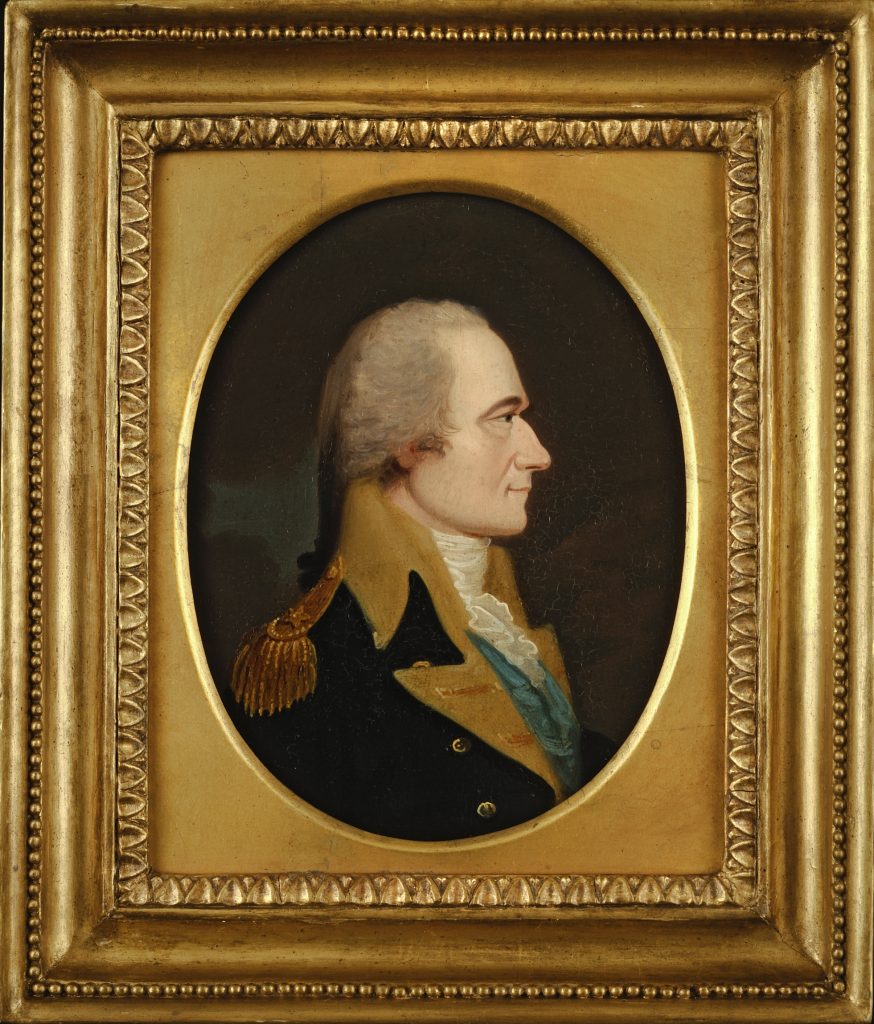
Alexander Hamilton
William J. Weaver (ca. 1759-1817)
ca. 1806Museum Acquisitions Fund purchase, 2016
Alexander Hamilton wore a uniform like the one depicted in this portrait as the senior major general in the U.S. Army during the Quasi-War with France in 1798-1800—but the artist mistakenly painted only one star on each epaulet instead of two. William J. Weaver painted versions of this posthumous oil-on-wood panel portrait for Hamilton’s friends and admirers. This example was owned in the nineteenth century by George W. Riggs of Washington, D.C.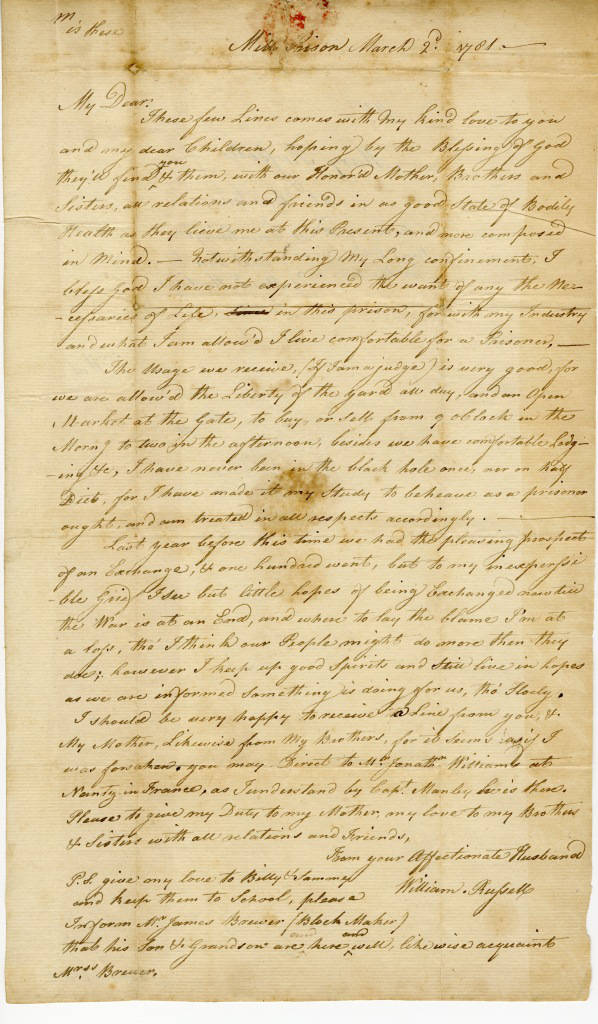
William Russell to Mary Russell
March 2, 1781The Robert Charles Lawrence Fergusson Collection
Russell was an American privateer who was captured by the British and held prisoner first at Mill Prison in England, and after his release he was recaptured and incarcerated in the prison ship 'Jersey' at New York. When he was finally released in March 1783, desperate to repay debts & provide for his family, he joined a merchant ship to make money before returning home to his family, but within a year he died of consumption.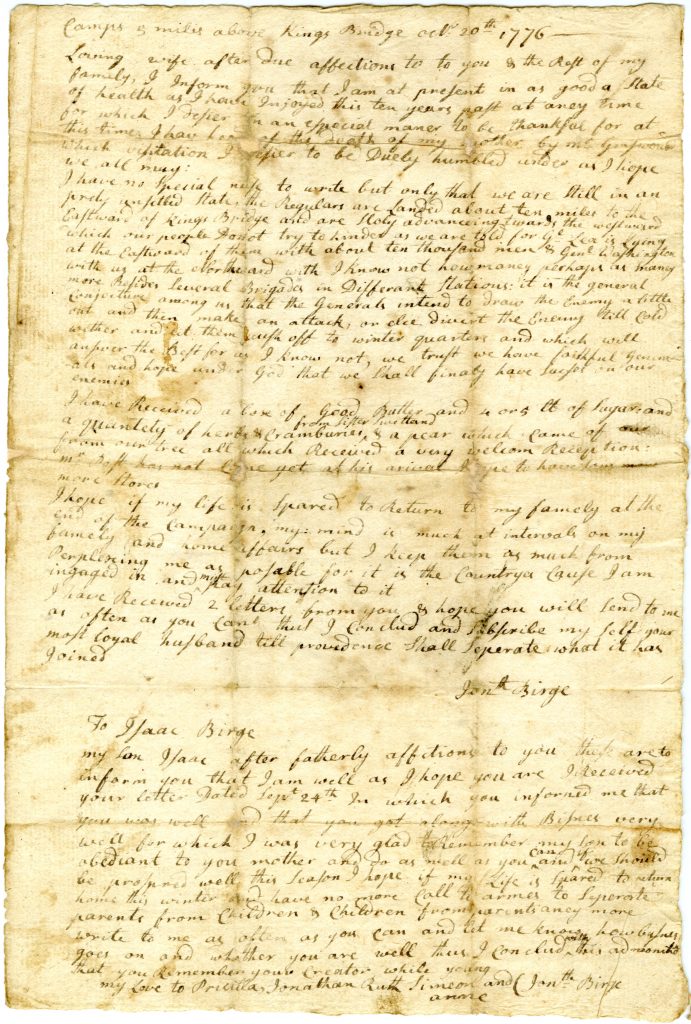
Jonathan Birge to Priscilla Birge
October 20, 1776The Robert Charles Lawrence Fergusson Collection
This is one of six letters written by Capt. Jonathan Birge of Connecticut to his wife describing the activities of his regiment during the difficult New York campaign. Emotions of love and loss are intertwined with details of company activities, troop movements, requests for supplies, sickness and causalities.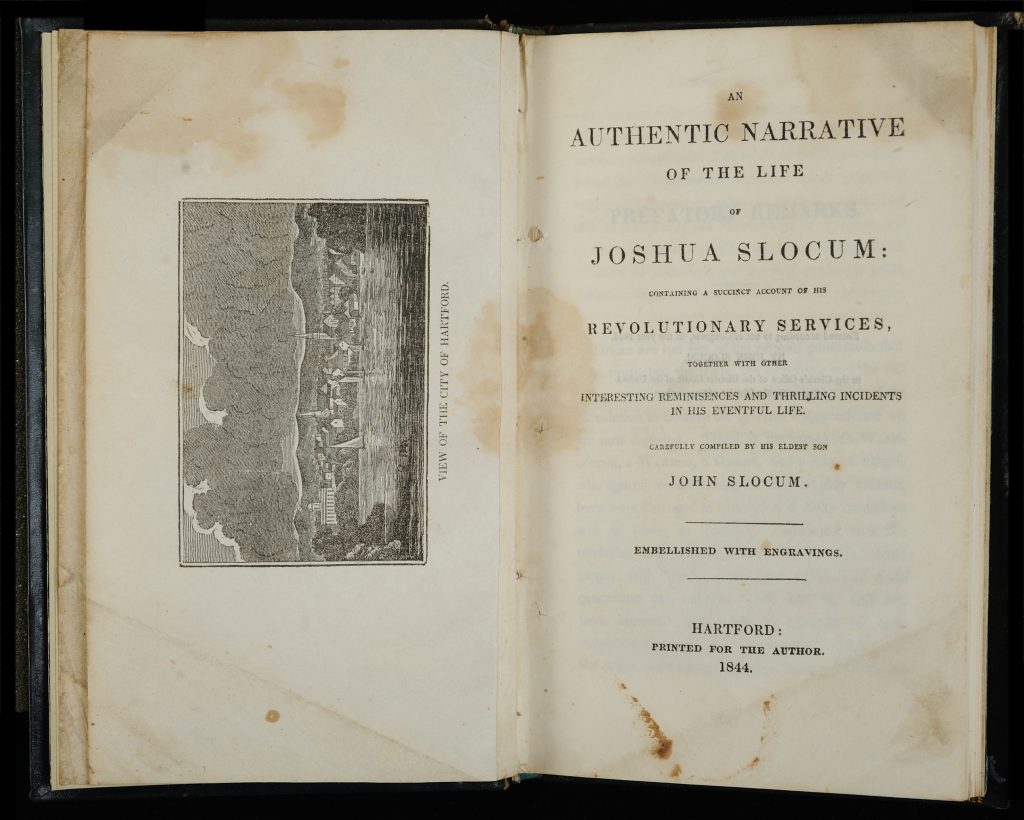
An Authentic Narrative of the Life of Joshua Slocum
Hartford: Printed for the author, 1844The Society of the Cincinnati, The Robert Charles Lawrence Fergusson Collection
Prefatory Remarks: “The names of a Washington, a Warren, a Green, and a host of others, who figured conspicuously in that mighty contest, have been blazoned in history, and their memories will go down to posterity embalmed with the tenderest recollections of the heart. … But while we concede to these renowned Generals and distinguished Civilians all the praise their exalted service deserve, we should not forget those who in a more humble and subordinate capacity, faithfully served their country … While yet they live,—while the low, glimmering, dying taper yet quivers into darkness, let them be respected; and let those of the present more selfish generation emulate their noble example” (pp. v-vi). Edited by John Slocum, the subject’s son. View of the city of Hartford on the frontispiece.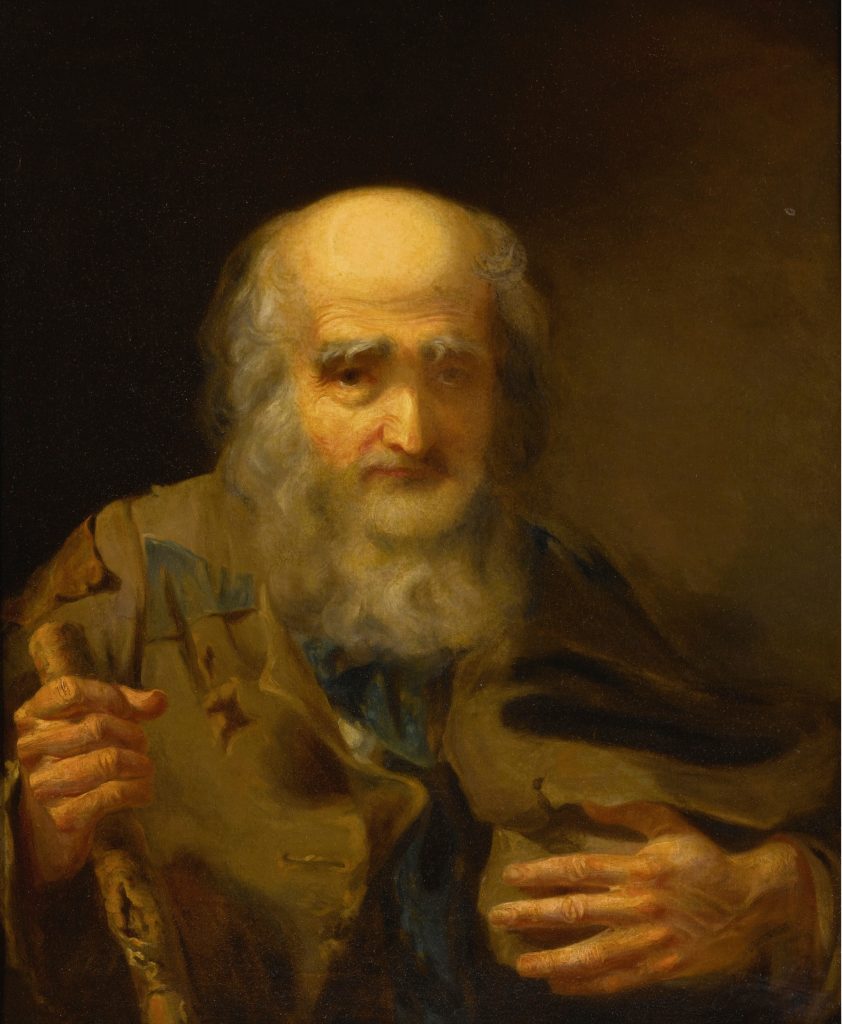
A Pensioner of the Revolution
John Neagle (1796-1865)
1830The Society of the Cincinnati, Museum purchase, 2017
This somber and arresting portrait depicts a homeless veteran living on the street in Philadelphia named Joseph Winter. The painting attracted popular attention in early 1831, when John Sartain published a mezzotint engraving of the work titled Patriotism and Age, which became a call to the conscience of the nation to care for those who had fought its battles and won its freedom.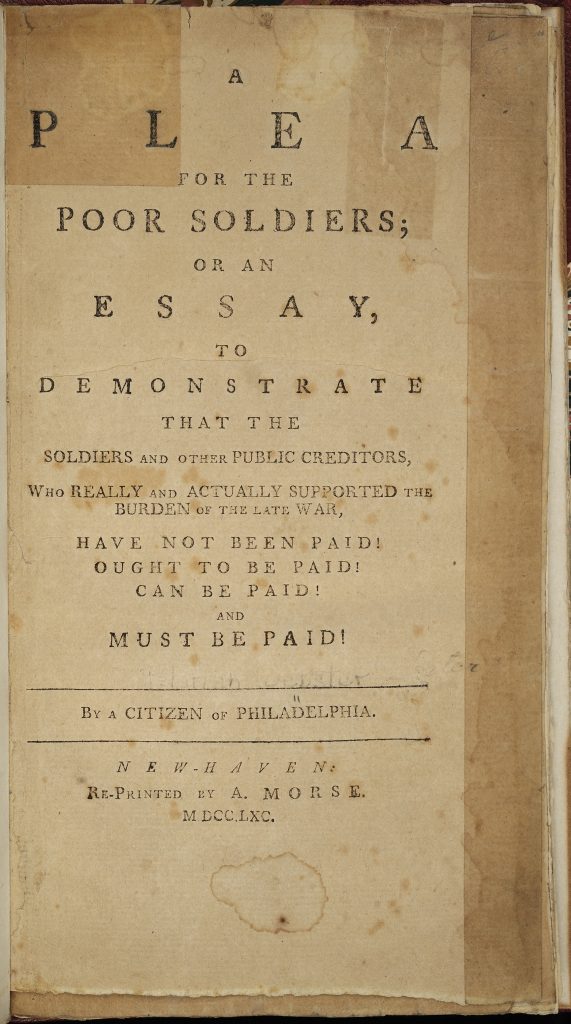
A Plea for the Poor Soldiers; or An Essay, to Demonstrate that the Soldiers and Other Public Creditors Who Really and Actually Supported the Burden of the Late War, Have Not Been Paid! Ought to be Paid! Can be Paid! And Must be Paid!
New-Haven: Re-printed by A. Morse, 1790The Society of the Cincinnati, The Robert Charles Lawrence Fergusson Collection
title page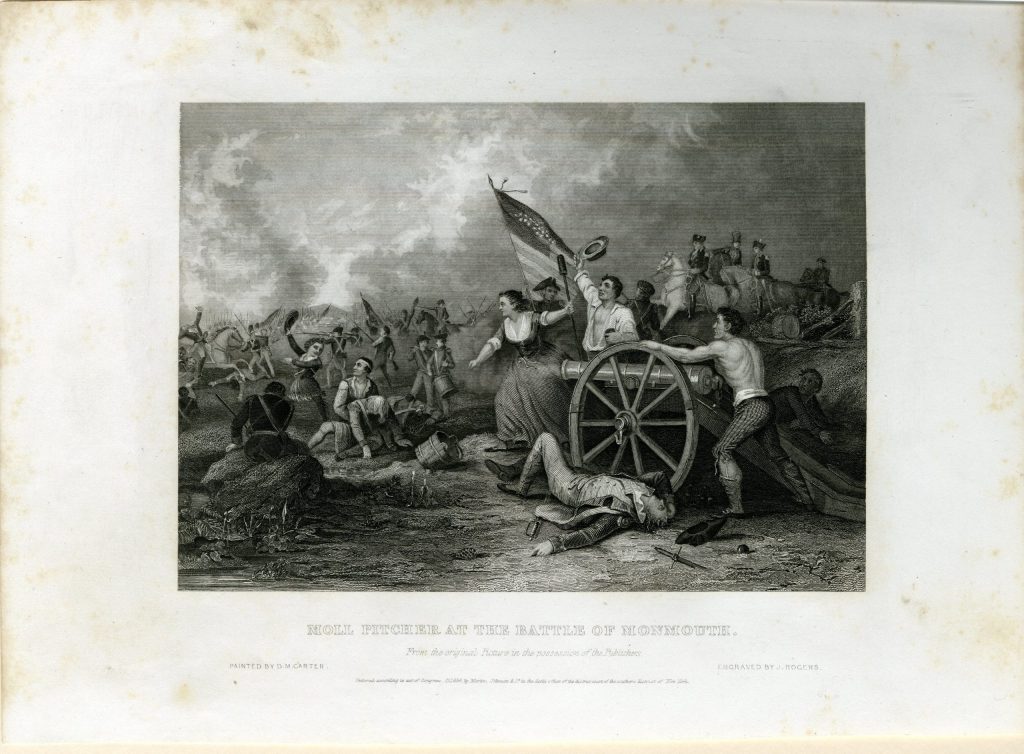
painted by D.M. Carter; engraved by John Rogers
New York: Martin, Johnson & Co., 1856
The Society of the Cincinnati
Battle scene with Molly Pitcher in the center assisting two solders fire a cannon next to an officer who lies mortally wounded. In the background to the right are a group of officers on horseback, the first of which appears to be George Washington.
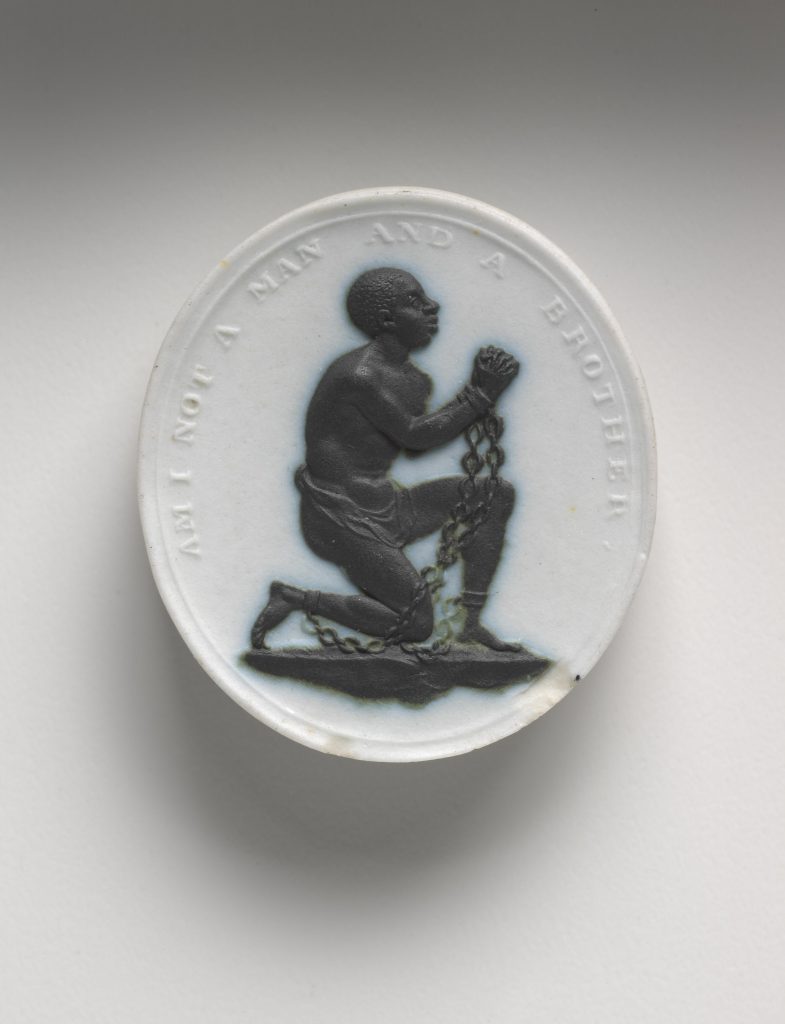
Anti-Slavery Medallion, Am I Not A Man and A Brother
Henry Webber, artist; Struck in Great Britain
1787The Diplomatic Reception Rooms, U.S. Department of State
This anti-slavery medallion was produced as part of the late 18th century abolitionist movement in Western Europe and America. Many abolitionists wore these medallions to clearly state their position and start conversations about slavery. These small porcelain and ceramic medallions were designed and produced by a team of craftsmen led by British potter Josiah Wedgwood. Over time, the medallions’ popularity grew, and the image appeared on a variety of objects, including chinaware, cufflinks, and pamphlets distributed by and among the activists.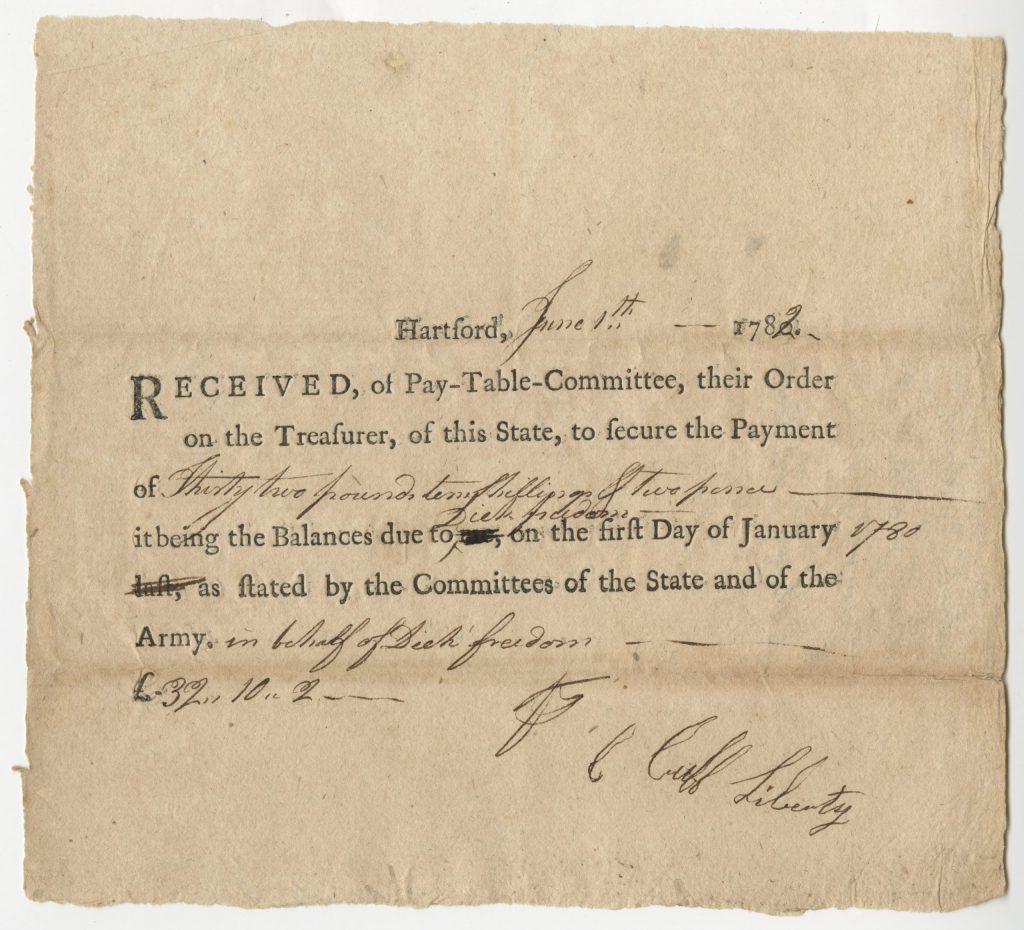
Partially printed D.S., Hartford, June 7th 1782: receipt of Pay-Table-Committee
Cuff Liberty, Dick Freedom, Committee of the Pay Table; Connecticut. Treasury Dept.
1782The Society of the Cincinnati, The Robert Charles Lawrence Fergusson Collection
Payment receipt signed for Dick Freedom by Cuff Liberty. Dick Freedom and Cuff Liberty were African American participants in the Revolutionary War who adopted aspirational names during their service. They served in the all-African American Second Company of the Fourth Connecticut Regiment.